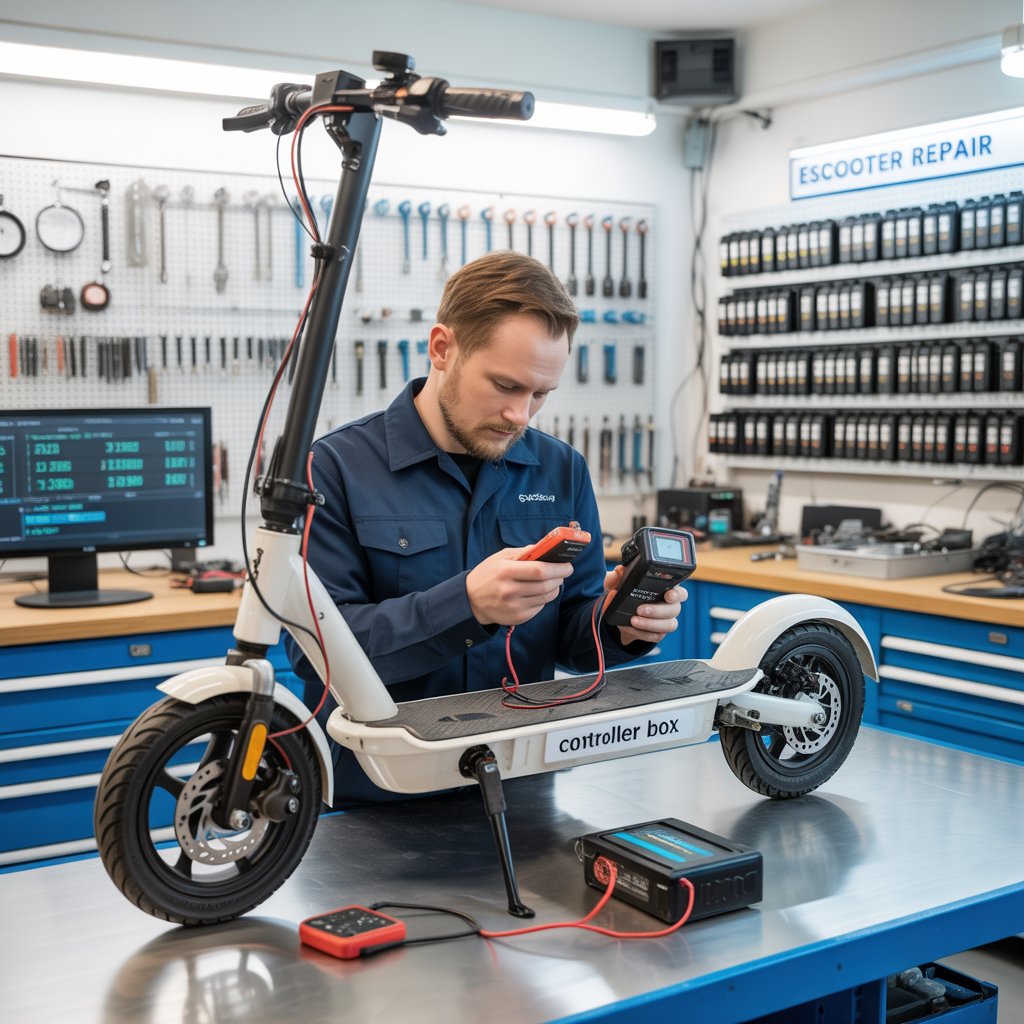When your electric scooter suddenly dies, refuses to charge, or rides weirdly, you might panic and type: Local Escooter Repair: What to Expect. But what actually goes on behind repair shop doors? How do you know who to trust, what you’ll pay, and whether it’s better to fix or replace?
This is your complete rider’s manual. Whether you’re a beginner or seasoned rider, here’s everything you need to know—from DIY tricks to deep diagnostics, red flags, part scams, regional pricing, and real insider insight.
Emergency: Scooter Not Turning On?

Before anything else, try these 3 quick checks before heading to a repair shop:
- Long-Press Power Button (10 sec): Some scooters freeze and need a soft reset.
- Inspect Charging Port: Dust or water may block contact. Try compressed air.
- Check Battery Connector: Loose connections can mimic battery death.
If nothing works, time to explore Local Escooter Repair: What to Expect.
Common Scooter Issues (Explained Simply)
Electric scooters may look simple, but their internals are often smarter than budget e-bikes. Below are 6 common failure zones, explained in human language:
1. Battery Memory Burnout
Over time, cheap battery management systems (BMS) misread charge levels. Result? Scooter shuts off at 40% or won’t charge past 80%.
Example: Like a fuel gauge stuck at half-tank when your car’s actually empty.
2. Controller Glitches
If your scooter jerks forward, stalls, or suddenly loses power during hills, it’s likely the controller — the scooter’s “brain” — misfiring power commands.
3. Hall Sensor Failures
The tiny sensors inside the motor detect wheel position. When they die, your wheel may spin erratically or not at all.
4. Wire Damage Near Folding Joints
Every time you fold/unfold the stem, wires bend. Over time, internal damage builds, causing loss of throttle, brakes, or display.
5. Brake Sensor Confusion
If your scooter randomly applies brakes, it may think you’re braking when you’re not. The cause? Misaligned magnetic brake sensor.
6. Firmware Freezes
Like phones, scooters run software. Corrupted firmware can cause false errors, power loss, or screen flickering.
Knowing these helps you understand Local Escooter Repair: What to Expect when you walk into a shop.
Premium Diagnosis: What Real Shops Do
Honest shops don’t just poke around. They follow a system. Here’s what premium repair diagnostics look like:
Phase 1: Electrical Isolation Test
Using a multimeter, they check voltages from battery terminals to controller, throttle, and brake levers.
Phase 2: Thermal Imaging Scan
Shops use FLIR cameras to spot components overheating in real time. Helpful for detecting motor stress and burnt wires.
Phase 3: Firmware Log Reading
Some brands allow firmware access via USB. Techs read internal logs to see what failed (e.g., battery spike, short circuit).
Phase 4: Load Simulation
They place your scooter on a dynamic test rig that simulates hills, stops, and weight.
A full scan like this helps define Local Escooter Repair: What to Expect at high-end service centers.
Red Flags & Shop Scams
Not all shops are honest. Here are 4 industry tricks riders should know:
1. Rewrapped Batteries
Used lithium cells are repackaged as “new.” These fail within weeks. Ask: Is this battery factory sealed? Does it come with date-stamp and serial?
2. Clone Controllers
Low-cost copies don’t handle current properly. Your range and throttle feel suffer. Ask: Is this an OEM controller with verified firmware?
3. Fake Tune-Ups
Some shops charge for “diagnostics” but only check tire pressure and clean dust.
4. Unnecessary Motor Replacements
A scooter may have Hall sensor issues but get quoted for a full motor swap.
Mechanic’s Note: “Most repairs are diagnostics, not replacements. If they instantly say ‘replace motor,’ walk away.”
Real Costs by Region
Prices vary widely by location. Here’s a basic breakdown:
| Service | USA ($) | South Asia (₹ / PKR) |
|---|---|---|
| Flat Tire Fix | $20–40 | ₹600–1200 / PKR 800–2000 |
| Controller Replacement | $80–160 | ₹4000–8000 / PKR 7000–12000 |
| Battery Swap | $150–300 | ₹8000–18000 / PKR 12000–25000 |
| Firmware Reset | $20–50 | ₹300–700 / PKR 500–1000 |
Note: These are average rates. Always confirm with your local shop.
Famous Scooter Brands: Known Issues
- Xiaomi: Sudden LCD blackout, BMS mismatch after third-party battery swap.
- Segway Ninebot: Frequent firmware lock issues, hard to reset at home.
- Dualtron: High performance, but prone to controller overheating on hills.
Easy DIY Fixes at Home
Some fixes don’t need a shop visit:
- Throttle not responding? Check if wires are tightly connected near the folding joint.
- Random brake light on? Clean the magnetic brake sensor near the lever.
- Scooter won’t turn on? Hold the power button for 10+ seconds to soft-reset.
Warning: Never open a battery case or controller unless you’re trained.
FAQ: Real Rider Questions
Q: Can I change my battery myself?
Only if it’s plug-and-play. Most batteries are soldered and sealed.
More info: Wikipedia on Lithium-ion battery
Q: Will repair void my warranty?
Yes, if non-OEM parts are used or you open sealed components.
Visit: [Your scooter brand’s support page] or check ridethebikes.xyz for brand-specific warranty tips.
Q: What if water entered my scooter?
Turn it off. Don’t plug it in. Let a technician inspect for corrosion.
For prevention tips: Scooter Water Damage Fix Guide
Q: Should I replace or repair?
If repair cost is over 60% of the scooter’s value, consider a new model.
Compare costs and models on: ridethebikes.xyz
Know Your Rights: Consumer Protection
- You can request original parts back after replacement.
- Ask for part warranty & labor warranty.
- Demand written or digital receipts with serials listed.
If unsure, record the issue and ask for a second opinion.
Final Thoughts: Be a Smart Rider
Understanding Local Escooter Repair: What to Expect puts the power back in your hands. No more guesswork. No more getting tricked.
Whether you’re dealing with hidden wire fatigue or scammed parts, this guide gives you the tools, knowledge, and confidence to make the right decision.
With this knowledge, you’re not just a rider — you’re the guardian of your electric journey.









